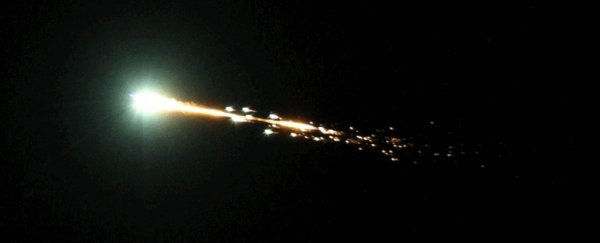A few months ago, on 18 December 2018, a massive airburst in the skies above Earth exploded with the equivalent of 173 kilotons of TNT.
That's over 10 times the amount released by the Hiroshima bombing (15 kilotons), and the third largest meteor explosion in over 100 years, coming in behind the 2013 Chelyabinsk explosion (440 kilotons) and the Tunguska event in 1908 (at least 3 megatons).
How on Earth do you miss such a huge explosion? Well, there wasn't anyone around to watch it happen.
It exploded above the clouds over the Bering Sea, near but not near enough to the closest land, Russia's Kamchatka Peninsula.
A meteor that explodes in a mid-air fireball is also known as a bolide.
According to meteor scientist Peter Brown of Western University in Canada, the event was detected by at least 16 infrasound monitoring stations around the world, a global network designed to monitor the planet for atmospheric nuclear explosions (but which can also detect events such as earthquakes, volcanic eruptions and, yes, bolides).
"When you see these infrasound waves, you know immediately that there has been an impact or a large release of energy," astronomer Alan Fitzsimmons of Queen's University Belfast told New Scientist.
NASA scientists independently received information about the explosion from US military satellites, which detected visible and infrared light from the bolide.
Additionally, its smoke trail was serendipitously caught on camera by the Japanese Himawari-8 weather satellite as the meteor was falling.
Some colour views of the #meteor that flew over the North Pacific in December 2018, taken by Japan's #Himawari satellite.
— Simon Proud (@simon_sat) March 18, 2019
The meteor is really clear here - bright orange fireball against the blue + white background!
Background: https://t.co/r403SQxicZ pic.twitter.com/ctNN8zxsXb
From the military data, NASA scientists were able to calculate that the meteor had been streaking through the atmosphere at a speed of around 115,200 kilometres per hour (71,600 miles per hour), at a steep 7-degree angle, and it exploded at an altitude of 25.6 kilometres (16 miles).
Based on the infrasound data, Brown was able to infer that the meteor was around 10 metres (33 feet) in diameter, with a mass of around 1,400 tons.
This is far below the 140-metre lower limit for potentially dangerous near-Earth asteroids NASA hopes to detect - but, at 20 metres, so was the Chelyabinsk meteor.
When that one exploded at an altitude of 23.3 km (14.5 miles) above Russia in 2013, the blast resulted in damaged buildings over several hundred kilometres, primarily from broken windows, and around 1,200 people injured, although no deaths were reported.
The Tunguska event flattened a region of Siberian forest measuring around 2,000 square kilometres (770 square miles).
So, although these events only happen less than a handful of times per century (and it's only a coincidence that the big ones have been over Russia), they can be incredibly destructive when they occur above land.
We are lucky that the Earth's surface is mostly sea - bolides harmlessly bursting apart over the ocean certainly aren't unheard of. For example, a bolide with the power of 12 kilotons of TNT exploded off the coast of Brazil in 2016, again revealed in data from military satellites after the event.
In fact, NASA has logged 774 atmospheric fireballs since 1988 at time of writing, the majority of which have occurred over the ocean.
It's estimated that millions of meteors enter Earth's atmosphere every day. The vast majority are tiny and burn up on atmospheric entry, but a few are large enough to explode - the larger the meteor, the larger the boom.
Those that are large enough to cause an event detectable by satellites and infrasound stations are relatively rare in comparison.
The Bering Sea bolide exploded near a commercial airline flight path between North America and Asia, so NASA is appealing to the relevant airlines for any sightings of the event. If we get real lucky, there may even be photos!
